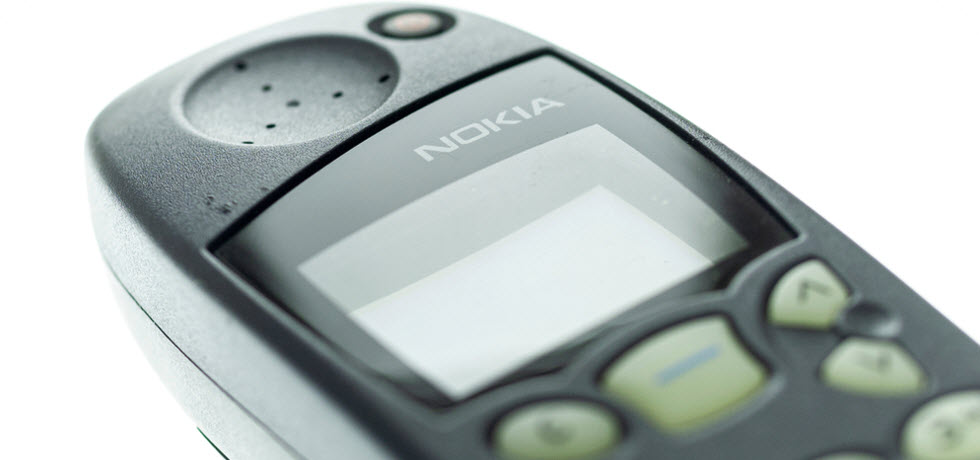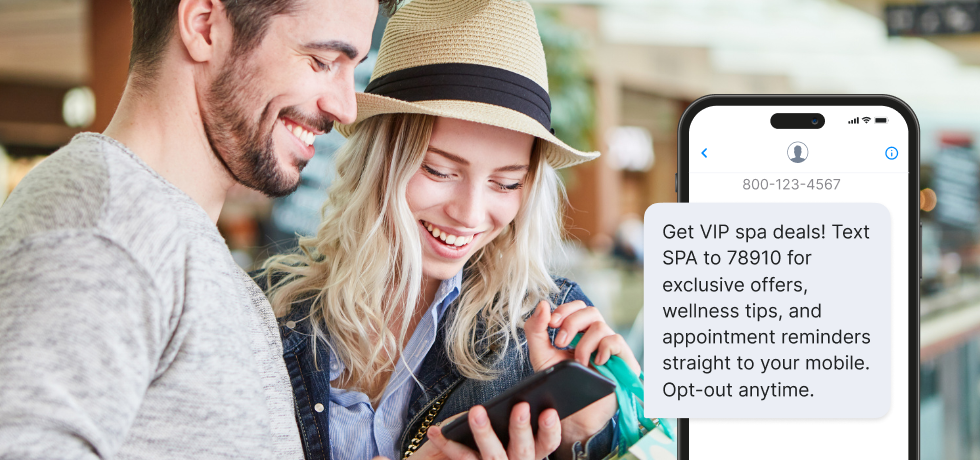
Mobile opt-in lists help businesses reach their audience in a personal, direct manner, using messages that resonate with their clients. While other channels, like email, become overcrowded with communications people usually ignore, direct texts ensure instant visibility and higher engagement.
People who have opted in to receive your written communications are the most receptive audience you’ll ever access. They are interested in your promotions, offers, and latest company news, which makes them more likely to see and act on your texts.
What is a mobile opt-in list?
Mobile opt-in lists consist of users who have given their consent to receive marketing messages from a business or organization.
Compared to social media subscriptions, mobile opt-ins work more like conventional channels like email and direct mail. Customers are asked for a point of contact by brands, and providing one essentially gives the brand approval to reach customers directly. Naturally, a mobile phone number serves as this point of contact for brands when sending voice, text, or other mobile messaging.
Opt-ins have social and mobile components for mobile marketing channels such as mobile web and mobile apps. Brands can use the mobile web to send users to a mobile landing page that includes clickable links and/or text inputs.
When customers download a mobile application, brands can communicate with them by asking for push notifications or location-based data.
Why are mobile opt-in lists important?
Mobile opt-in lists are important for several reasons:
- Direct and personalized communication: Allows for immediate, personalized contact with clients, enhancing engagement and loyalty.
- Cost-effectiveness and efficiency: Delivers messages at a reduced cost compared to other channels, with high engagement rates.
- Customer engagement: Mobile opt-in lists allow for direct and personalized interaction with customers, fostering higher engagement rates compared to other marketing channels.
- Trust and loyalty: When customers opt in to receive messages, they demonstrate trust in the brand. Respecting this trust by sending valuable and relevant information can enhance loyalty.
- Compliance and consent: Ensures communication is compliant with laws like the TCPA in the US and GDPR in Europe, respecting privacy and consent. Explicit opt-in mechanisms like checkboxes on web forms that are not pre-ticked show clear opt-in intent from the subscriber.
10 Strategies to encourage mobile opt-ins
Here are nine effective strategies to boost your mobile opt-in rates, ensuring a growing, engaged subscriber base for your SMS marketing campaigns:
1. Use your email customer base as a starting point
Your email customer base is the best place for you to start. This already includes your loyal customers and is the ideal springboard for launching a successful text marketing campaign. To kick-start your new program, first, send your email customers a special message informing them about your new texting program.
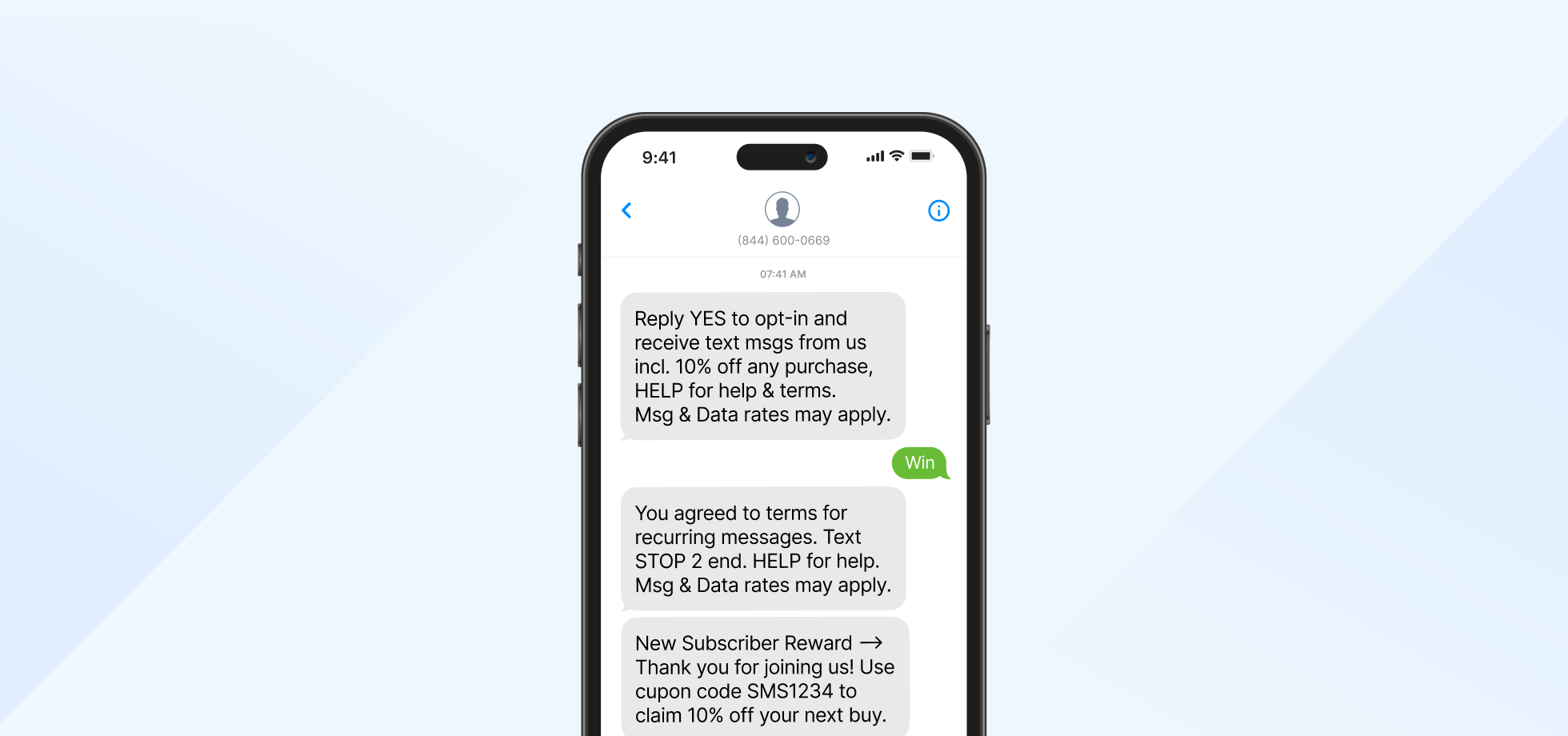
In the email, highlight the benefits of joining the program (access to exclusive sales and discounts, appointment reminders, VIP access to events, etc.). Be sure to give them clear instructions on how to opt in.
Example:
Text OPT IN to 54321 to receive texts with exclusive offers and discounts.
2. Leverage website integration
Adding opt-in forms on key web pages
To ensure increased visibility, place your opt-in forms on your homepage, blog posts, the checkout page, and the about page. This is where your subscribers are most engaged and look for the value proposition.
Clearly communicate what they will receive by opting in, such as exclusive offers, early access to new products, or valuable insights and tips.
Keep the opt-in form simple and ask for minimal information (usually just a mobile number and a name), making it easy and quick for users to subscribe, and include a link to your privacy policy next to the opt-in form, to enhance trust.
Using pop-ups and banners to promote mobile subscriptions
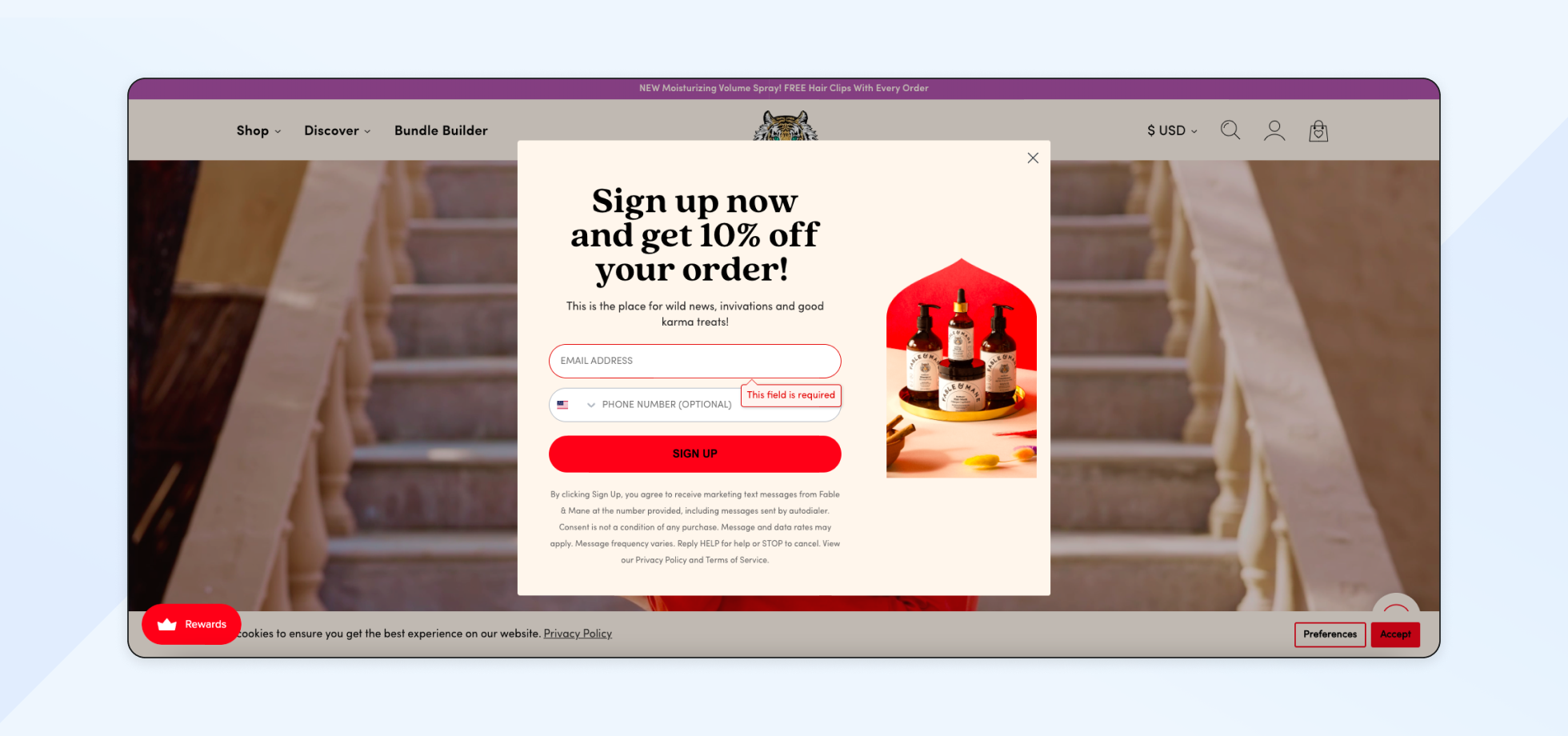
Implementing pop-ups that appear after a user has spent a certain amount of time on the site can capture the interest of engaged visitors. Include incentives for signing up, like discounts or free downloads.
Implement exit-intent pop-ups as a last resort to convert the visitor into a subscriber by offering something valuable in exchange for their mobile number.
- Use persistent or sticky banners: These are less intrusive alternatives to pop-ups and can be placed at the top or bottom of the screen, ensuring visibility without hindering the user experience.
- Ensure design consistency: Banners and pop-ups should complement the site’s design, maintaining the overall aesthetic and user interface harmony.
- Personalize messages: Tailor the messages on banners and pop-ups to match the content of the page they appear on, which can help improve conversion rates.
- Implement A/B testing: Experiment with different messages, designs, and placements to discover what resonates best with your audience and maximizes engagement.
3. Integrate SMS across all media
The companies that see the best results in creating their opt-in base are those that incorporate SMS into all of their marketing media. The more integrated you make your text marketing push, the more customers will opt in. Make sure you let customers know how to opt into your texting program via:
- In-store signage
- Billboards
- Leaflets
- Kiosks
- Social media
- Website
- Radio and television
- Any other form of advertising your brand uses.
Domino’s has strategically expanded its mobile ordering capabilities by introducing text orders. This comes as an addition to their suite of digital innovations, which already included ordering via tweets and voice commands.
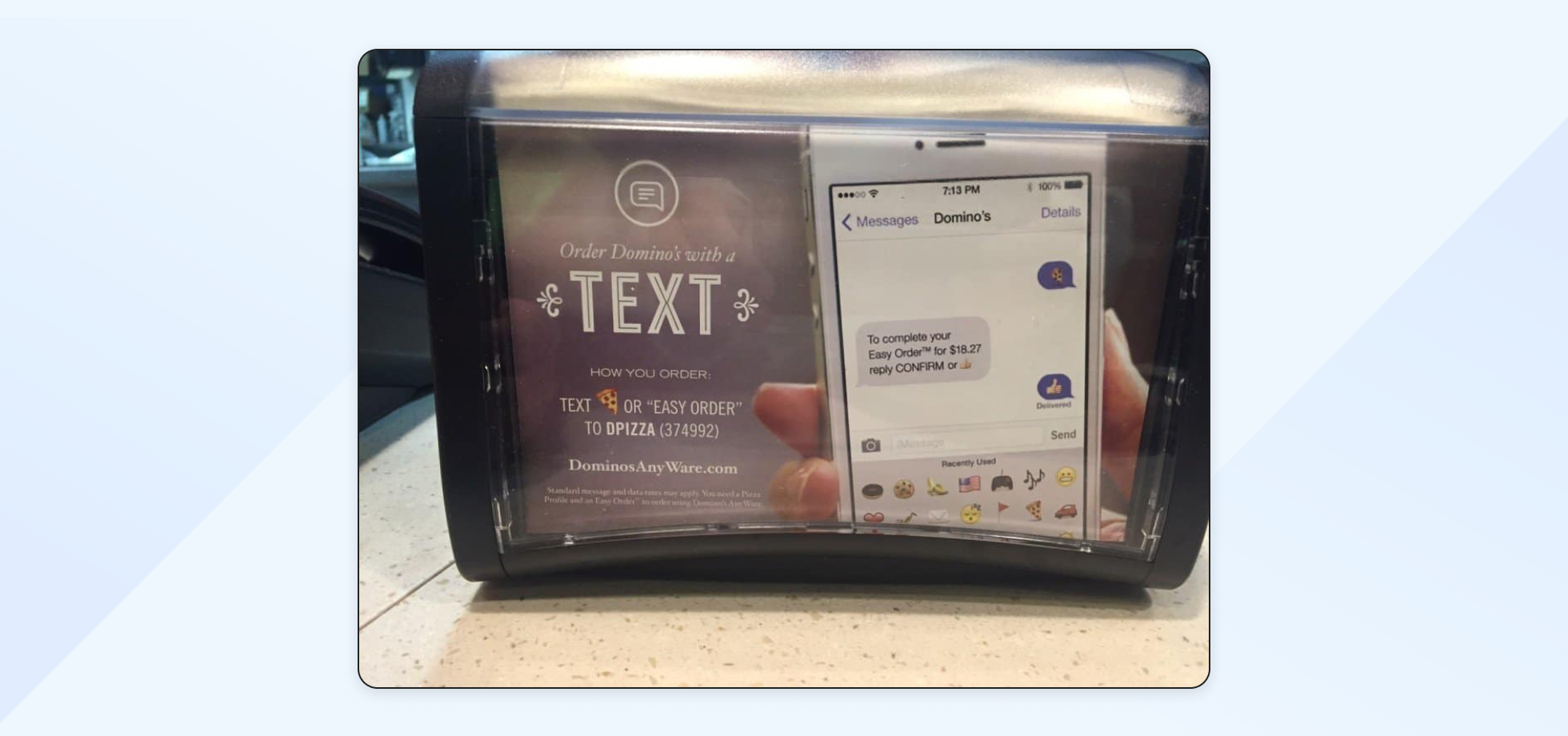
To use this service, customers need to opt-in and link their mobile number to their Pizza Profile on Domino’s website. This lets them reorder by simply texting a pizza emoji or “Easy Order” to a designated number.
By incorporating various modern technologies such as smart TV apps, smartwatch apps, and integration with vehicle systems, Domino’s has significantly increased digital sales. Half of their sales now come from digital platforms—25% via mobile devices.
Employees should also be coached on how to effectively give information and instructions to customers on how to opt in. Example:
If you’re interested in exclusive discounts and events from our store, sign up for our texting program by texting OPT IN to 87654.
4. Use customer reviews to your advantage
Highlight positive reviews
Collect reviews from your website, social media pages, third-party review sites (e.g., Yelp, Google My Business, Trustpilot), and direct feedback from customers. To increase their number, implement automated systems to request reviews post-purchase or service via email or SMS. Testimonials (e.g., video, text, images) can make the feedback seem more genuine and relatable.
Display them in your marketing materials and across social media, and incorporate snippets from positive reviews in your SMS or app push notifications to reinforce the value of staying subscribed to your list.
Use social media, email newsletters, and websites to showcase customer testimonials

Use engaging visuals or create short video clips of customers sharing their experiences to capture attention, then post them on social media.
Include a section in your email newsletters dedicated to customer stories or a ‘review of the month.’ On your website, you can create a dedicated testimonials page where you can include testimonials on relevant product pages or landing pages for specific campaigns.
Engage reviewers with personalized invitations to join the mobile list
Reach out to customers who have left positive reviews with a personalized thank you message, inviting them to join your mobile opt-in list for exclusive updates or offers.
Make sure to offer something of value, like a discount on their next purchase or early access to new products, engaging them with your brand even more.
Incorporate customer testimonials in mobile content to reinforce subscriber decisions
To reassure subscribers that they’ve made the right decision and reduce opt-out rates include customer testimonials in your app. Strategically integrate testimonials into your mobile marketing: for example, if sending a promotional message about a particular product, include a brief customer quote praising it. This adds credibility to your promotion and can enhance conversion rates.
5. Have in-store promotions
QR codes and in-store signage to promote mobile list sign-ups
Place these codes in high-traffic areas, such as near the checkout counter, on product shelves, and at the entrance. Offer immediate incentives for customers who sign up via the QR code, like a discount on their purchase, a free item, or access to an exclusive sale.
Make sure that scanning the code is simple and straightforward. A complicated sign-up can drive potential subscribers away. Keep your landing page mobile-friendly, requiring minimal input.
Starbucks used this strategy to promote its mobile app and the Starbucks Rewards loyalty program. After signing up, new members of the Starbucks Rewards program receive immediate incentives, such as a free drink or bonus points for future purchases. This instant gratification encourages more customers to take the time to scan the QR code and join the program.
Exclusive in-store benefits for mobile subscribers
Offer special discounts that are only available to customers who have joined your mobile list. Communicate them via text messages and let clients redeem in-store, to create a tangible connection between the mobile opt-in and in-store benefits.
Use the data you collect with mobile sign-ups to offer personalized deals that cater to the individual preferences and purchase history of the subscriber. Personalization increases the relevance and effectiveness of your communications, encouraging more sign-ups.
Offer personalized discounts, exclusive previews, and tailored recommendations for your subscribers. If you have a loyalty program, integrate it with your mobile list.
6. Make it exclusive
One thing that appeals to texting customers is that they can get access to sales and discounts that are only available via SMS. Customers will be more motivated to sign up if they know that they’ll gain special benefits from doing so.
However, if you offer the same discounts via social media and email, then customers may not see the point in joining the SMS program too. So make sure you let them know that by opting in, they’ll gain access to exclusive deals available only to customers in the SMS program.
Kiehl’s cosmetics company advertised its SMS campaign by promising customers up to three location-based text offers per month. Besides growing their opt-in list, they gained a 73% redemption rate on their offers. These exclusive deals were appealing to customers because they offered value to them and could only be accessed through the SMS campaign.
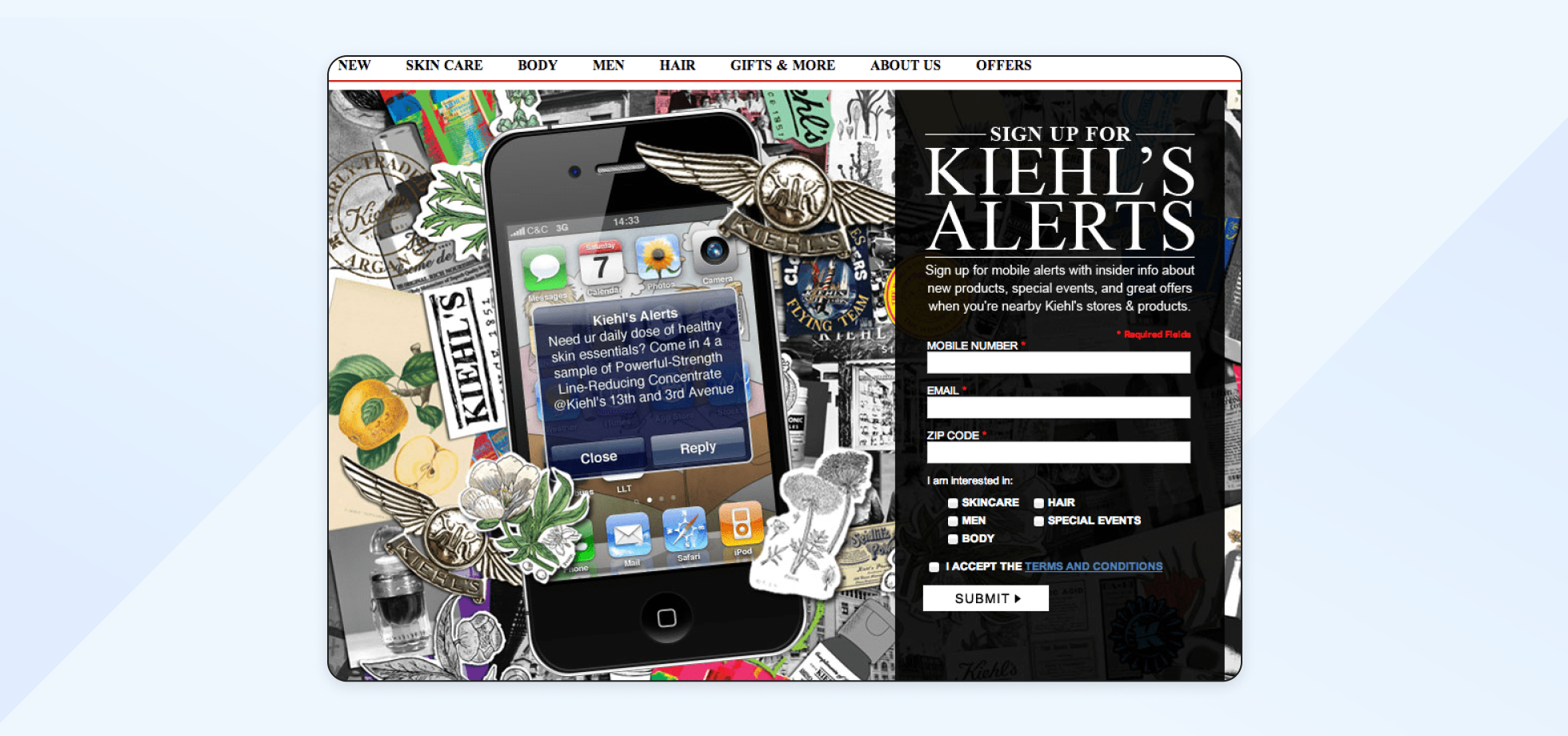
7. Run a contest
People love free things. One of the best ways to get people to sign up for anything, including your SMS program, is by giving something away. Crown Events Management launched an SMS sweepstakes campaign during the live event and live streaming of the 2021 AMA Supercross Races.
Participants had a chance to win a GoPro Hero 9 camera simply by texting the word GOPROSX to the number 65047. People entered the competition in thousands, and their phone numbers and email addresses were automatically added to their mobile opt-in list, and their social media following also increased.
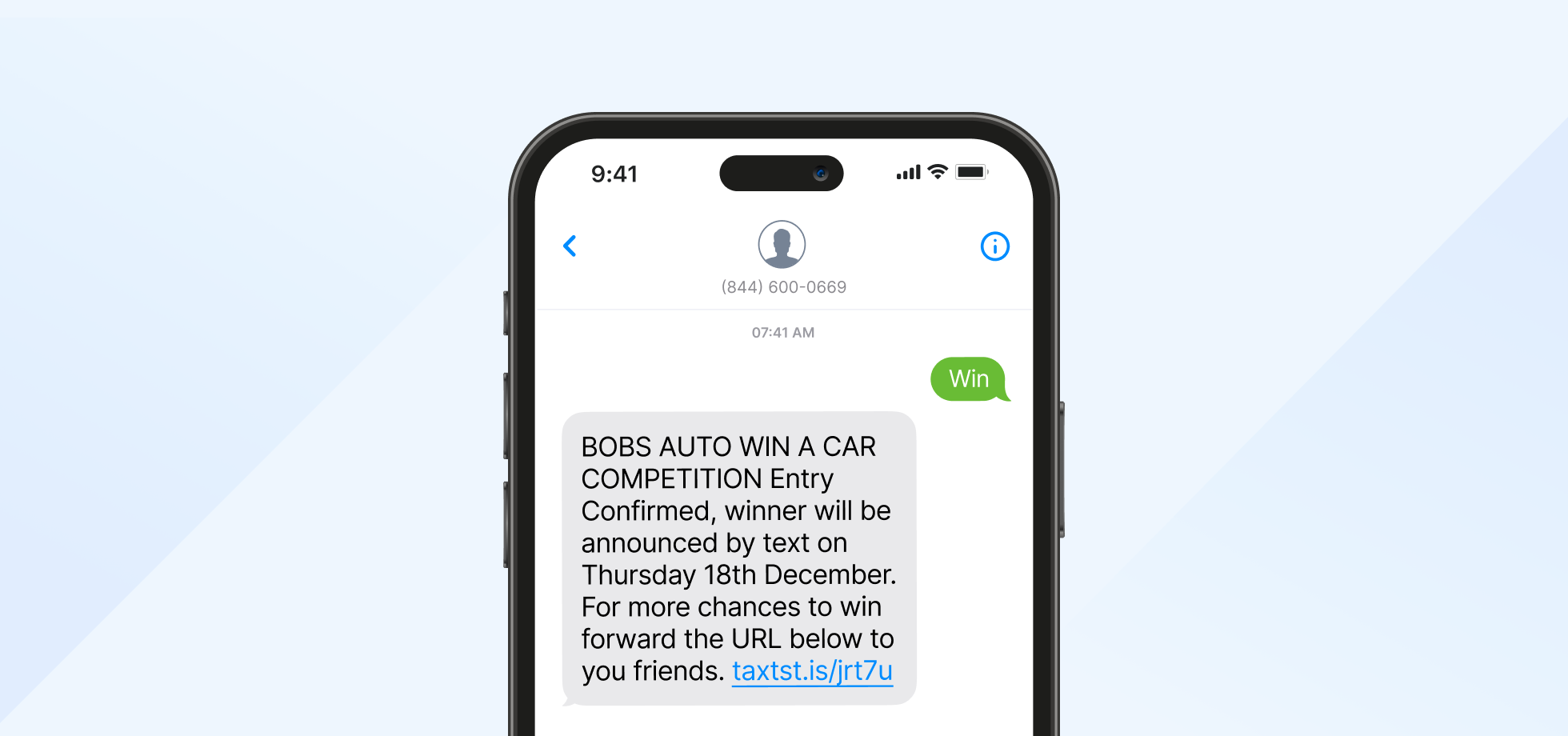
This strategy even worked for Peta2, a youth nonprofit organization for animal rights. Participants were offered free buttons, sunglasses, or bags for opting in to their text campaign to raise awareness of cigarette testing on animals. An impressive 25,000 people opted in.
Though in these case studies, the organizations were very different, one was a for-profit business and the other a nonprofit organization, both were able to meet their goal of increasing their SMS opt-ins by offering free stuff.
8. Offer a promotion
You don’t necessarily have to give things away to entice people to your SMS campaign. A well-planned promotional push can also generate impressive results.
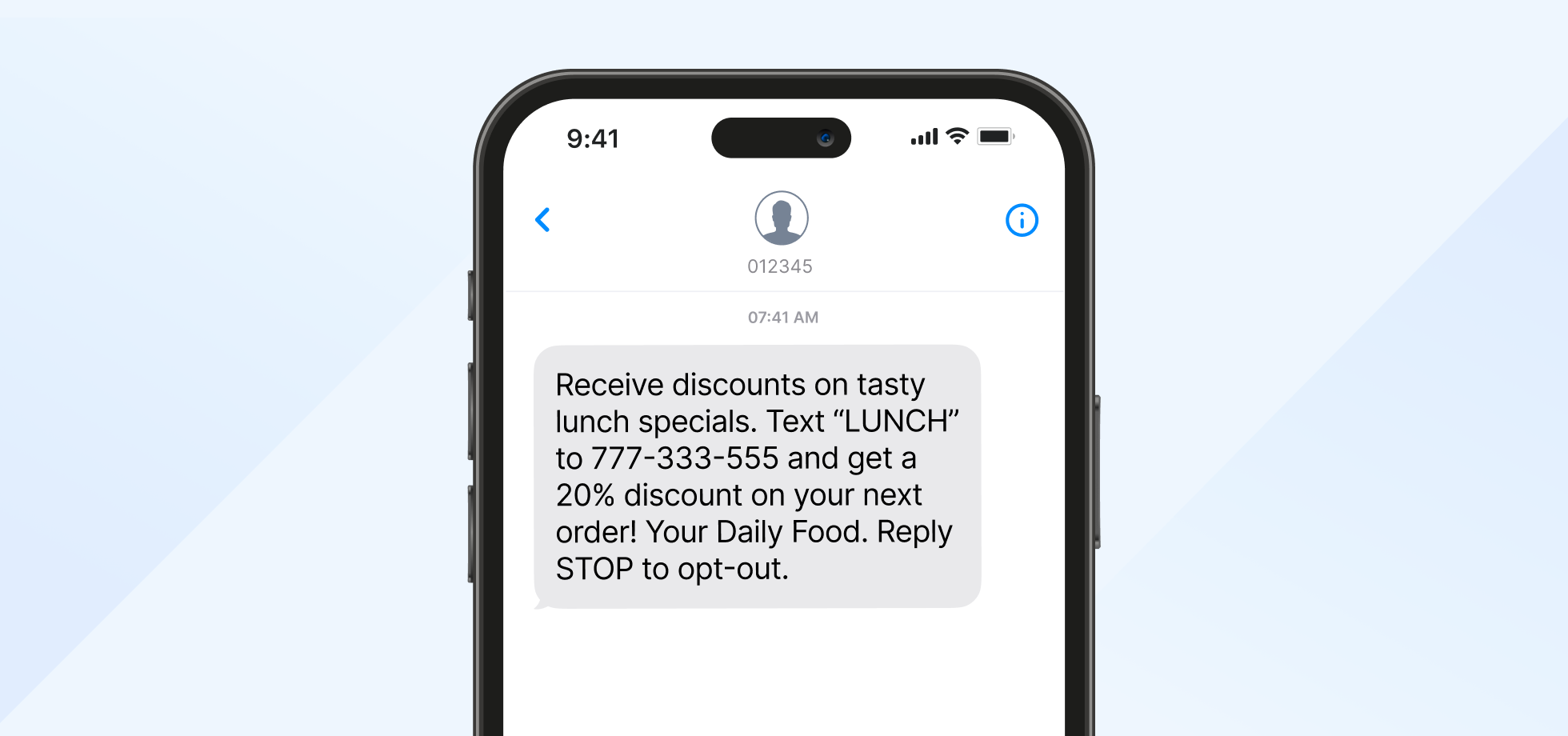
For instance, Redbox DVD rental kiosks ran a promotional campaign called “10 Days of Deals”, where participants texted “DEALS“ to their SMS number on each of the 10 campaign days in order to win anything from 10 cents to $1.50 on their next video rental. They also advertised via their email database, Facebook page, and at their kiosks. 400,000 customers participated, thus substantially increasing the company’s opt-in list and revenue.
Taco Bell ran a campaign offering a free Frutista Freeze with any food item purchase and increased their opt-ins by 13,000 subscribers in just 5 weeks. As you can see, promotions can also generate incredible results for your texting campaigns, including growing your opt-in list.
9. Leverage customer service
Make use of every interaction with your customers to provide value and build trust. For instance, after concluding a customer support interaction, the representative managing the inquiry might suggest, “If you’re interested in receiving tips, updates, or offers through text messages, simply send ‘CARE’ to 1235 to join our mailing list.”
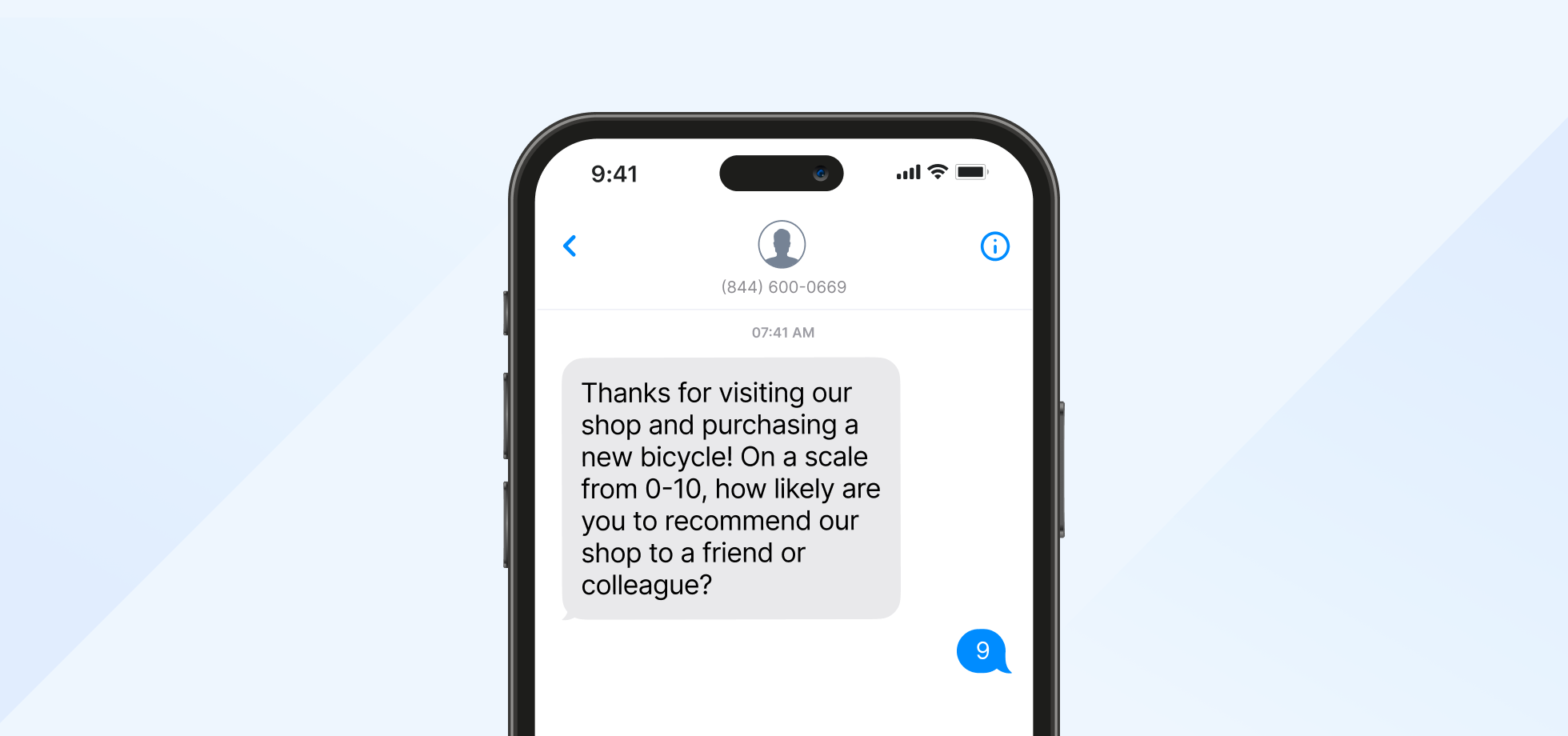
Offer customers a special discount or bonus service for opting into your mobile list during a service interaction. This can be framed as a thank-you for their loyalty or as part of a customer appreciation initiative.
10. Promote Membership Benefits
Offering membership benefits can significantly increase mobile opt-ins by providing additional value and exclusivity. Encourage your customers to join a membership program where mobile subscribers receive unique perks such as early access to sales, member-only discounts, or loyalty points.
Create a tiered membership system where mobile subscribers can unlock higher levels of rewards based on their engagement and loyalty. This not only incentivizes sign-ups but also encourages continued participation.
How to keep subscribers engaged over time
Keeping subscribers engaged requires a blend of valuable content, personalized interactions, and regular updates. Here are key strategies:
- Use subscriber data to personalize content based on interests, behaviors, and previous interactions. Make sure to implement dynamic content in your communications that automatically adjusts based on the subscriber’s profile or actions. To do this, you can use marketing automation tools that change parts of your message based on the data associated with each subscriber.
- Include information that subscribers find valuable, such as exclusive tips, early access to new products, or insider industry insights. Offer tutorials, how-tos, or educational materials that help subscribers get more out of your products or services.
- Keep a regular schedule for your communications but avoid overwhelming your subscriber list. Build a routine they can anticipate. Determine the best communication frequency through testing and feedback to maintain engagement without causing fatigue.
- Share UGC (User-generated content) as social proof to build trust and community. This can include customer reviews, testimonials, or user-shared photos and videos. Celebrate personal milestones like subscriber birthdays or the anniversary of their subscription with special offers or messages.
- Use surveys or polls to gather feedback and find suggestions for improvement. Show subscribers that their feedback is valued by acting on it and communicating changes or updates made based on their input.
Spotify introduced features like the ability to find songs by lyrics, a sleep timer, and enhanced playlist customization options, all of which were highly requested by users.
- Test different aspects of your mobile communications (e.g., subject lines, content formats, send times) to understand what works best. Schedule your tests during similar times and days to avoid external factors messing up the results and adapt your strategies based on performance data, subscriber feedback, and changing market.
Conclusion
Mobile opt-in lists need continuous engagement, personalized interactions, and a deep understanding of your audience’s needs and preferences to maintain their effectiveness and value over time. This requires a proactive and strategic approach to mobile marketing that puts the subscriber experience first.
It involves integrating opt-in opportunities into customer care interactions, utilizing personalized follow-ups, and offering exclusive content or services that cater specifically to mobile subscribers. All of these strategies are exemplified above to help you make the decisions for your business.
Ultimately, the goal is not just to grow your list but to cultivate a community of engaged subscribers who look forward to your communications. Keep an eye on emerging trends and technologies that can boost your mobile marketing efforts to maintain relevance and engagement in a competitive digital landscape, and never stop innovating.
Related articles
Mastering the transactional model of communication for effective business collaboration
Learn how applying this model in business settings c...
What is product-led growth, and how to apply it to your SaaS company
PLG (product-led growth) is gaining popularity as th...
How to build and rebuild trust with your customers
Knowing how to build trust with customers is one of ...
Cold texting: A complete guide & why you should warm text instead
This article explains the concept of cold texting an...
When was texting invented: A history over 30 years in the making
From the early days of mobile communication to the b...




